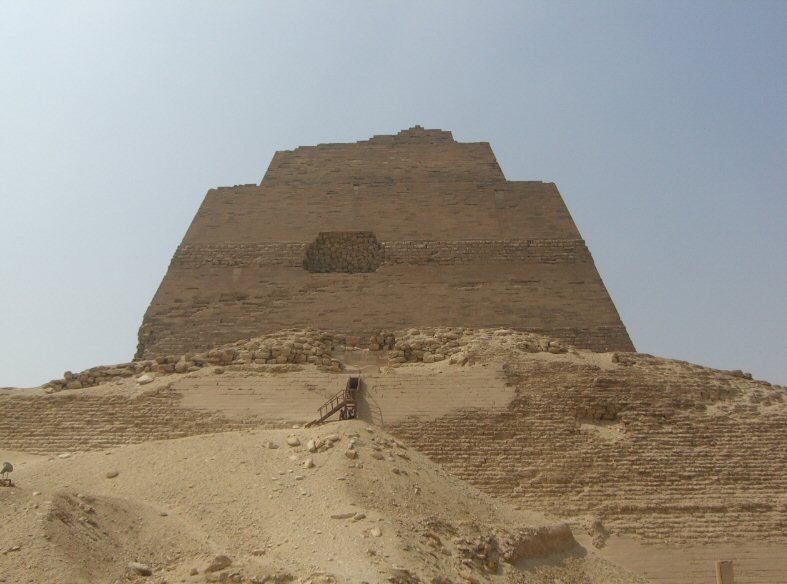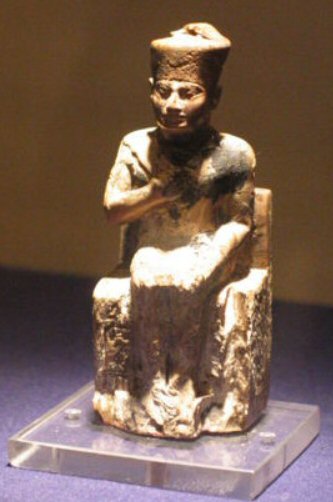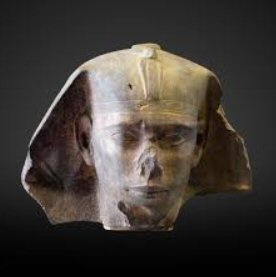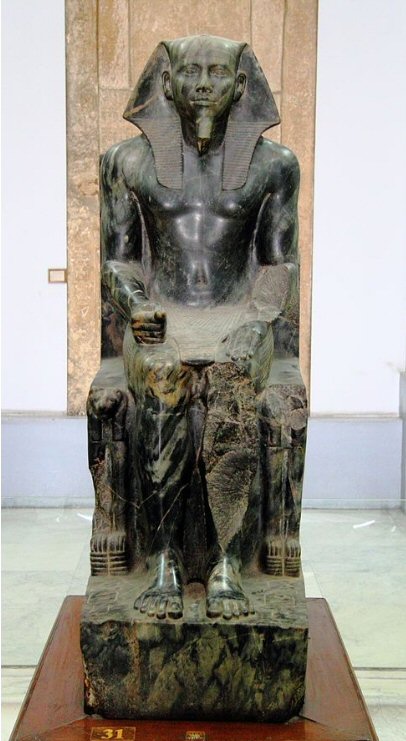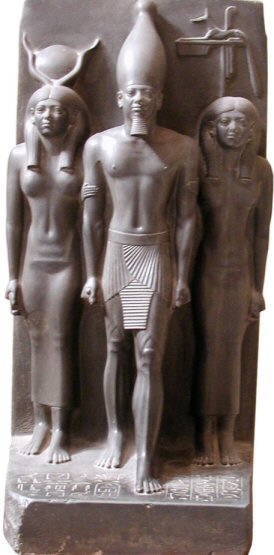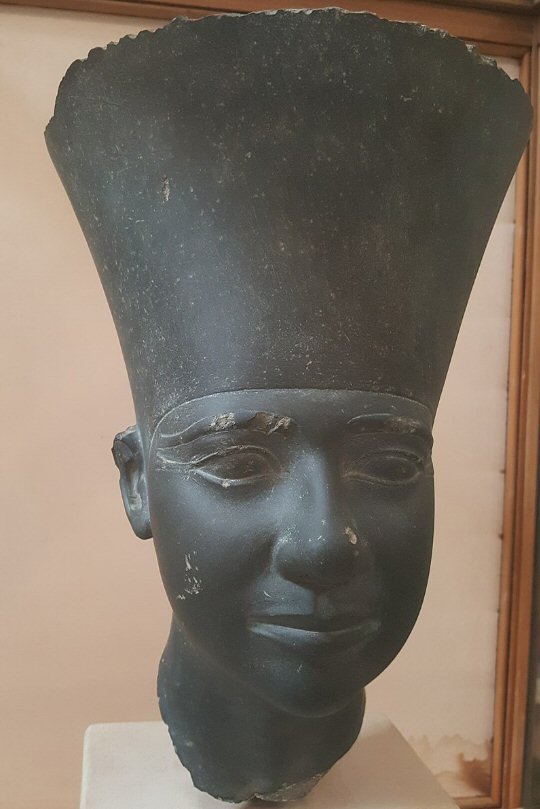Sneferu
 He is always referred to as the 'Successor of Huni'. His mother Meresankh was not royal-blooded, thus she was one of Huni's concubines. However, there is no definite proof for this, but if she was, her son would have married one of his half-sisters, Hetepheres I, (the mother of Cheops and another daughter of Huni), in order to confirm by blood the legitimacy of his rule.
He is always referred to as the 'Successor of Huni'. His mother Meresankh was not royal-blooded, thus she was one of Huni's concubines. However, there is no definite proof for this, but if she was, her son would have married one of his half-sisters, Hetepheres I, (the mother of Cheops and another daughter of Huni), in order to confirm by blood the legitimacy of his rule.
Like his predecessors, Sneferu soon became a legendary figure and he even became an ideal king in the Middle Kingdom whom later Egyptian rulers sought to emulate. He ruled for 24 years. There is not a literary reference to his reign, which appears to have been both glorious and long-lasting.
The Palermo Stone suggests that Sneferu was a warlike king, he was said to have led an expedition into Nubia to put down a revolt, and to have captured 7000 prisoners in the campaign. The campaign account also mentions the high number of 200,000 cattle heads as well as 13,100 cattle. According to the same source obtained in a campaign against the Libyans, 11,000 of them were to have been taken prisoners.
As for Nubia, from the beginning of the Archaic Period it provided Egypt with a source of manpower both for major building works and for the maintenance of order. Nubia played a great role also in guarding the trade routes for the African products such as ebony, ivory, incense, exotic animals, ostrich eggs, and panther skins. Nubia also enabled to control the sources of certain raw materials, such as gold mines located throughout the desert in Nubia from Wadi Allaqi to the Nile and the diorite quarries to the west of Abu Simbel. It was this willingness to obtain raw materials that led to the campaigns into Sinai which were sent by the Old Kingdom rulers from Sa-nakhet onwards. Their aim was not only to contend with the possible invaders from Syria-Palestine, but to use copper, turquoise and malachite mines in the western part of Sinai. Sneferu led an expedition against the Bedouins of Sinai. He must certainly have done much to establish Egyptian mines in the region, judging from the popularity of his cult among Middle Kingdom miners in Sinai.
Throughout his reign, Egypt had commercial links with Lebanon and Syria via the Phoenician Seaboard. He sent a fleet consisting of 40 ships for getting some timbers, which were always in short supply in Egypt, to be used as blocks of stones inside his pyramids.
Sneferu was the only ruler to whom three pyramids are ascribed. Initially he built a tomb at Meidum, some distance to the south of his predecessors' pyramids at Saqqara. The first tomb, modeled closely on Djoser's Step Pyramid at Saqqara, was barely finished when he abandoned it. In the 13th year of his reign, he undertook two new buildings at Dahshur, both of which were intended to be perfect pyramids. It is difficult to understand why the royal necropolis was moved from south to Meidum then back north again.
The choice of Meidum must have been a deliberate attempt to break with the previous dynasty, therefore clearly belonged to the first half of Sneferu's reign. The royal family seems to have developed links with the Meidum area, since members of the elder branch of the family were buried there, notable Nefermaat, who was Sneferu's vizier and the architect of King Huni's tomb. Nefermaat's son, Hemiunu, became Cheops's vizier and was also the builder of Cheops's Great Pyramid at Giza. Hemiunu was rewarded by allowing him to place his own tomb nearby, at Giza.
Sneferu was a great man of achievements, and was a kind king. In the 12th Dynasty, when he was deified, the kings of that dynasty chose Dahshur, near Snefru's pyramids to build theirs. Also, they considered this area as sacred. Sneferu was mentioned in the Westcar Papyrus in a way showing him very decent and kind with graceful manners. The reliefs of his temple and his tomb are evidence that art flourished during Sneferu Reign, either at Dahshur or at Meidum.
Keops - Khufu
 Khufu was the Ancient Egyptian name for Cheops (Greek form), and it is the abbreviated form of "Hnm-hw.f wi" that means "Khnum protects me". We are not definitely sure whether Khufu was the eldest son of Sneferu, thus the legitimate heir to the throne, or he was a governor of one of the provinces of Egypt that might be EI-Menia. This last hypothesis is based on the name of this province Mn't-hw.f-wi ' which means 'the Nurse of Khufu'. However, it has been suggested that this province was only a village which Khufu inherited from his father Sneferu. It was called 'Mn't Sneferu' and then changed into 'Mn't-hw.f-wi', considered as a province of the 16th nome of Upper Egypt.
Khufu was the Ancient Egyptian name for Cheops (Greek form), and it is the abbreviated form of "Hnm-hw.f wi" that means "Khnum protects me". We are not definitely sure whether Khufu was the eldest son of Sneferu, thus the legitimate heir to the throne, or he was a governor of one of the provinces of Egypt that might be EI-Menia. This last hypothesis is based on the name of this province Mn't-hw.f-wi ' which means 'the Nurse of Khufu'. However, it has been suggested that this province was only a village which Khufu inherited from his father Sneferu. It was called 'Mn't Sneferu' and then changed into 'Mn't-hw.f-wi', considered as a province of the 16th nome of Upper Egypt.
It seems that since the Second Dynasty, some Egyptians settled in Gubeal onwards the north of Beirut. In Khufu Reign, an Egyptian temple was erected in Gubeal, on which Sneferu's name and his successors' was found inscribed.
The Fourth Dynasty necropolis was undoubtedly the Giza Plateau, dominated by the pyramids of Cheops and his successors. The Giza pyramids were surrounded by streets of Mastaba tombs belonging to the officers and dignitaries who continued to attend their master's courts in the hereafter. Khufu was still attested in the Saite Period (the 26th Dynasty), and was increasingly popular during the Roman Period.
According to Papyrus Westcar, Khufu liked to listen to some stories of his predecessors' reigns. In this text, he is portrayed as the traditional legendary monarch, good-natured and eager to be shown amiable towards his inferiors and interested in the nature of human existence.
The fourth tale in Papyrus Westcar describes his request for 'the secret chambers of the sanctuary of Thoth' which he wanted to reproduce in his mortuary temple. Then he became acquainted with a magician from Meidum, called Djedi. Djedi revealed that the secret he desired would be passed to him by the first king of the next dynasty, who is the eldest son of the matrimony of Re and a Heliopolitan priest's wife.
The rest of Papyrus Westcar describes the marvelous birth of the Fifth-Dynasty three first rulers. The text breaks off before the end of the story. Considering that his tomb was the largest monument in Egypt and one of the Seven Wonders of the World, it was surprising that the only surviving sculpture of Cheops is a tiny ivory statuette (9 cm high).
The broken fragments of this unique portrait were found at Abydos by Flinders Petrie and the reconstructed statuette is now displayed at the Cairo Museum. A graffito in Wadi Maghara shows that he continued his father's work in Sinai, and a stela in the diorite quarries of the Nubian shows that he also continued this work till the south of the First Cataract.
According to the Turin Canon, Khufu reigned 23 years, and the length ascribed to him by Manetho is 63 years. Khufu's two sons, each born from a different mother, succeeded him to the throne. The first son was Djedefre who ascended the throne at the death of his father.
Djedefre
 The personality of Djedefre and his reign are still obscure. It is not even possible to say whether he reigned for only 8 years, as the Turin Canon indicates, or for a longer period.His rise to power marks an indisputable turning point, since he was the first Egyptian ruler to include among his titles the name 'Son of Re'. His tomb was not in Giza, but in Abu Roash, about 1 km to the north of Giza.
The personality of Djedefre and his reign are still obscure. It is not even possible to say whether he reigned for only 8 years, as the Turin Canon indicates, or for a longer period.His rise to power marks an indisputable turning point, since he was the first Egyptian ruler to include among his titles the name 'Son of Re'. His tomb was not in Giza, but in Abu Roash, about 1 km to the north of Giza.
The choice of Abu-Roash for the new necropolis was not arbitrary, and this part of the Plateau had already been used for burial in the Third Dynasty. Djedefre also returned to the north-south orientation of the pyramid and an overall rectangular ground plan for the complex which was probably inspired by the Saqqara pyramids. This complex, including a mortuary temple, a sloping causeway and a still unexcavated valley temple was ultimately left unfinished, leading to speculation that Djedefre's reign was comparatively short. In 1901, E.
Chassinat discovered in the area around the pyramid a large number of quartzite fragments (displayed now in Louvre Museum) which originally made up a set of about 20 statues representing the king. The best examples of these royal statues from Abu-Roash are among the masterpieces of Old Kingdom royal sculpture.
The position of Djedefre in the royal family, particularly his relationship with his half-brother Chephren, who succeeded him to the throne, is unclear. His mother's name is unknown, but he is thought to have married his half-sister, Hetepheres II who was also the wife of Kawab, Cheops' crown prince who died before his father without assuming the role of vizier.
The tomb of Kawab, one of the earliest in the Giza necropolis, is to the east of Cheops' pyramid and it is clear that his memory was still maintained up to the time of Ramses II at least. For Ramses' son Khaemwaset is known to have restored a statue of Kawab in the temple at Memphis. Merseankh III, the daughter of Kawab and Hetepheres II, married Chephren, whereas Neferhetepes, the daughter of Djedefre and Hetepheres II is one of the possible candidates for the mother of Userkaf.
Post-Cheops Struggle
 After the death of Kawab, Djedethor, who was half-brother of Djedefre, remained his only rival to the throne. An unfinished and deliberately damaged Mastaba, discovered near the Kawab's tomb, is probably an indication of a struggle for the regency between Djedefhor and Djedefre. Djedethor was the father of Queen Khentkawes, and she is the mother of Neferirkare and Sahure. She was probably the historical model of a woman mentioned in Papyrus Westcar, under the name Redjedet, and who according to the magician Djedi was destined to give birth to the children of Re, the first kings of the Fifth Dynasty. Therefore, there might have been a struggle between two rival branches of the royal family: Djedefre might have gained the upper hand over Djedefhor temporarily, but power would have been restored to the elder branch of the family (Djedefhor's) with the reign of Chephren. This is supported by later references to Cheops' sons. A Twelfth Dynasty graffito found in the Wadi Hammamat includes Djedefhor and his other half-brother Baefre in the succession of Cheops after Chephren.
After the death of Kawab, Djedethor, who was half-brother of Djedefre, remained his only rival to the throne. An unfinished and deliberately damaged Mastaba, discovered near the Kawab's tomb, is probably an indication of a struggle for the regency between Djedefhor and Djedefre. Djedethor was the father of Queen Khentkawes, and she is the mother of Neferirkare and Sahure. She was probably the historical model of a woman mentioned in Papyrus Westcar, under the name Redjedet, and who according to the magician Djedi was destined to give birth to the children of Re, the first kings of the Fifth Dynasty. Therefore, there might have been a struggle between two rival branches of the royal family: Djedefre might have gained the upper hand over Djedefhor temporarily, but power would have been restored to the elder branch of the family (Djedefhor's) with the reign of Chephren. This is supported by later references to Cheops' sons. A Twelfth Dynasty graffito found in the Wadi Hammamat includes Djedefhor and his other half-brother Baefre in the succession of Cheops after Chephren.
Kefren - Khaefre
 His reign lasted over 25 years. He moved the royal necropolis back to Giza, building his own pyramid and a valley temple on the south of his father's tomb, using limestone and granite. Auguste Mariette cleared the main hall of the temple in 1860. Among several fragments that had fallen into a shaft, he discovered a statue which is now one of the most magnificent objects at the Egyptian Museum in Cairo.
His reign lasted over 25 years. He moved the royal necropolis back to Giza, building his own pyramid and a valley temple on the south of his father's tomb, using limestone and granite. Auguste Mariette cleared the main hall of the temple in 1860. Among several fragments that had fallen into a shaft, he discovered a statue which is now one of the most magnificent objects at the Egyptian Museum in Cairo.
A representation of Chephren seated on the royal throne, was protected by god Horus who wraps his wings around the nape of Chephren's neck. Chephren seems to have pursued the same theological course as his predecessor. He continued to bear the title of 'Son of Re', and also developed a masterly way of Atum, next to Re, which has already been emphasized by Djedefre.
Micherinos -Menkaure
After the death of Chephren, the other branch members of the family took over the throne. Chephren's immediate successor was his son Menkaure (Stable are the Kas of Re). Between Chephren and Mycerinus, Manetbo adds another ruler called Baefre (Re is his Ba). His unfinished pyramid was probably found at Zawiyet el-Aryan.
Menkaure was the last son. After Menkaure's second son, Shepseskaf, rose to the throne, he completed his father's mortuary temple and perhaps even his pyramid. Manetho is uncertain about Menkaure Reign's length, which probably extended over 18 years rather than 28. The country started to

suffer from economic crises because all financial sources were spend on the ambitious building projects, the thing that made the country go through bad economic conditions.
Shepseskaf
He was Mycerinus's son and the last king of the Fourth Dynasty. He reigned no more than four years, and he tried to minimize the influence of the Re's priesthood, which had increased and become noticeable since Chephren's time. Also, the name of Re became a part of the names of this Dynasty's kings, not only as a means of respect, but the fifth name of the king that is the 'Son of Re' started to appear since the Chephren's time.
Shepseskaf, unlike all his predecessors, did not affix Re's name to his. This proves that he did not believe in the Re's cult because he found that Re's priests became very influential, not only on the religious affairs, but also on the country's political policy.
He chose a different religious policy for his reign, issuing a decree which safeguarded the funerary estates of the early kings. But he broke tradition by having his tomb at southern Saqqara, it was as a giant sarcophagus not a pyramid. This was not only for economic reasons, but also for emphasizing that he did not believe in the Re's cult. Furthermore, he abandoned the site of Giza.
His tomb at saqqara is known as 'Mastabet Pharoh'. The tomb is 100m long, 72m wide and 18m high. On the eastern side of the tomb, he set up the mortuary temple, then the causeway, and the valley temple. However, the building was not completed, and Shepseskaf was not buried inside it. He married  Khentkawes, Djedefhor's daughter, who is described in her Giza tomb as 'the Mother of the Two Kings of Upper and lower Egypt'. No doubt, this inscription is a reference to Sahure and Neferirkare, that she was considered by the Egyptians to have been the ancestress of the Fifth Dynasty.
Khentkawes, Djedefhor's daughter, who is described in her Giza tomb as 'the Mother of the Two Kings of Upper and lower Egypt'. No doubt, this inscription is a reference to Sahure and Neferirkare, that she was considered by the Egyptians to have been the ancestress of the Fifth Dynasty.
Shepseskaf does not seem to have produced heir by Khentkawes, unless one think of Djedefptah that was mentioned by Manetho, to whom the Turin Canon ascribes a reign of two years. His wife had two tombs: one at Giza and the other at Abusir, near her son's pyramid. Her tomb's style indicates a return to the architectural tradition of the Third Dynasty. This apparent move, taken from the Heliopolitan tradition, also expressed Shepseskafs choice of Ptahshepses, the chief priest of Memphis, as the husband of his daughter Khamaat.
After the death of Shepseskaf, struggle took place between the members of the royal family, then one of them called Djedefptah ascended the throne and ruled for 2 years. During this trouble period, Khentkawes played a role in changing the royal family.
Khentkawes

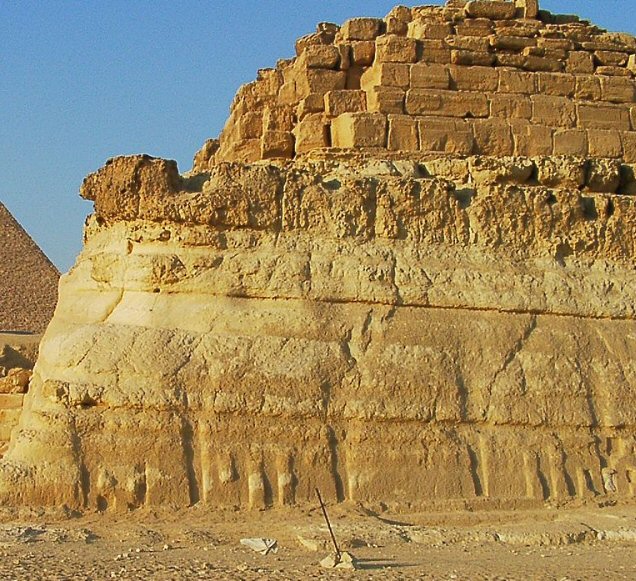
In 1931-1932, the expedition of the Cairo University in Giza revealed what was thought to be an incomplete pyramid, a building called 'Lepsius 100'. This building resembles a huge sarcophagus, similar to Shepseskaf's tomb. Discoveries assured that this tomb belonges to Khentkawes.
As much as the origins of Khentkawes are concerned, most opinions agree that she was the daughter of Mycerinus, although we have no evidence to prove that. She was married to Shepseskaf. She outlived him and existed during Djedefptah's reign. Later on, she married Re's high priest who was called Userkaf and who founded the Fifth Dynasty. She was the mother of Userkaf's sons: Sahure and Neferirkare.
